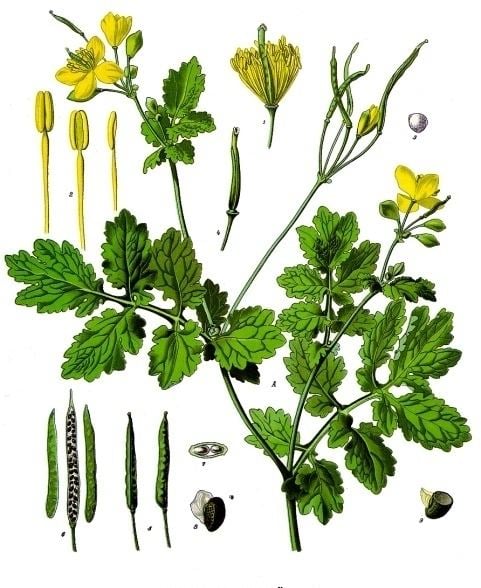Higher classification Chelidonium | Scientific name Chelidonium majus Rank Species | |
 | ||
Genus ChelidoniumTourn. ex L. Similar Yarrow, Common comfrey, Perforate St John's‑wort, Papaveraceae, Milk thistle | ||
A closer look at greater celandine chelidonium majus
Chelidonium majus, commonly known as greater celandine or tetterwort,(although tetterwort also refers to Sanguinaria canadensis), nipplewort, or swallowwort, is a herbaceous perennial plant, the only species in the genus Chelidonium. It is native to Europe and western Asia and introduced widely in North America.
Contents
- A closer look at greater celandine chelidonium majus
- Chelidonium majus
- Taxonomy and naming
- Description
- Pharmacology
- Herbalism
- References
While the greater celandine belongs to the poppy family, the lesser celandine belongs to the buttercup family.
Chelidonium majus
Taxonomy and naming
The greater celandine is one of the many species described by the father of taxonomy, Carl Linnaeus, in volume one of his Species Plantarum in 1753. According to the Oxford English Dictionary, celandine comes from Late Latin celidonia, from earlier Latin chelidonia or chelidonium, and ultimately from Ancient Greek χελιδόνιον, from χελιδών (chelidṓn) "swallow". Ancient writers said that the flower bloomed when the swallows returned and faded when they left.
Description
Greater celandine is a perennial herb with an erect habit, and reaches 30 to 120 cm high. The leaves are pinnate with lobed and wavy-edged margins, up to 30 cm long. When injured, the plant exudes a yellow to orange latex.
The flowers consist of four yellow petals, each about 1 cm long, with two sepals. A double-flowered variety occurs naturally. The flowers appear from late spring to summer in umbelliform cymes of about 4 flowers.
The seeds are small and black, borne in a long, cylindrical capsule. Each has an elaiosome, which attracts ants to disperse the seeds (myrmecochory).
It is considered an aggressive invasive plant in natural areas. Control is obtained mainly via pulling or spraying the plant before seed dispersal.
Pharmacology
The whole plant is toxic in moderate doses as it contains a range of isoquinoline alkaloids but there are numerous therapeutic uses when used at the correct dosage. The main alkaloid present in the herb and root is coptisine. Other alkaloids present include methyl 2'-(7,8-dihydrosanguinarine-8-yl)acetate, allocryptopine, stylopine, protopine, norchelidonine, berberine, chelidonine, sanguinarine, chelerythrine, and 8-hydroxydihydrosanguinarine. Sanguinarine is particularly toxic with an LD50 of 18 mg per kg body weight (IP in rats). Caffeic acid derivatives, such as caffeoylmalic acid, are also present.
Some alkaloids have shown potential activity against methicillin-resistant Staphylococcus aureus.
The effect of the fresh herb is of a mild analgesic, cholagogic, antimicrobial, oncostatic and central nervous system sedative. In vitro experiments on animal cells have shown celandine to be cytostatic. An immune stimulating effect has also been noted. Some studies show that the alkaloid extraction can have the same effects. The alkaloids are known to cause immobilization in mice after being ingested orally or injected. The alkaloids cause limpness and tone reduction of smooth muscle in rabbits. The alkaloids are also noted to stimulate the heart and lungs of frogs, cats and dogs, raising the blood pressure and widening the arteries.
The latex could be employed for cauterizing small open wounds. Early studies of celandine showed that it causes contact dermatitis and eye irritation, particularly from contact with the poisonous red to yellow latex of the stem. This effect has not been observed in animal studies; no inflammation was observed in rabbit eye tests. The latex can leave a non-permanent stain. Stains on skin of the fingers are sometimes reported to cause eye irritation after rubbing the eyes or handling contact lenses. The latex is also known to stain clothes.
The characteristic latex also contains proteolytic enzymes and the phytocystatin chelidostatin, a cysteine protease inhibitor. These co-constituents could explain the topical use of greater celandine against warts and moles.
"Ukrain" (Ukrainian: Україн) is an alternative medicine promoted to treat cancer based on chelidonium. The drug was created in 1978 by the Ukrainian chemist Vasyl Novytskyi. The drug is named in honor of the nation of Ukraine and is produced by an Austrian company Nowicky Pharma. Although the drug was never approved by any regulators, Novytskyi claimed it to be a complete cure for all cancers, radiation-induced diseases and AIDS and was arrested in Vienna for aggravated fraud on September 4, 2012.
C. majus has shown analgesic activity at 200 mg/kg dose in mice.
Herbalism
The aerial parts and roots of greater celandine are used in herbalism. The above-ground parts are gathered during the flowering season and dried at high temperatures. The root is harvested in autumn between August and October and dried. The fresh rhizome is also used. Celandine has a hot and bitter taste. Preparations are made from alcoholic and hot aqueous extractions (tea). The related plant bloodroot has similar chemical composition and uses as greater celandine.
As far back as Pliny the Elder and Dioscorides (1st century CE) this herb has been recognized as a useful detoxifying agent. The root has been chewed to relieve toothache. John Gerard's Herball (1597) states that "the juice of the herbe is good to sharpen the sight, for it cleanseth and consumeth away slimie things that cleave about the ball of the eye and hinder the sight and especially being boiled with honey in a brasen vessell."
It was formerly used by gypsies as a foot refresher; modern herbalists use its purgative properties. The modern herbalist Juliette de Baïracli Levy recommended greater celandine diluted with milk for the eyes and the latex for getting rid of warts. Chelidonium was a favourite herb of the French herbalist Maurice Mességué. Chelidonium majus has traditionally been used for treatment of various inflammatory diseases including atopic dermatitis. It is also traditionally used in the treatment of gallstones and dyspepsia.
The Iroquois give an infusion of whole plant, another plant and milk to pigs that drool and have sudden movements.
